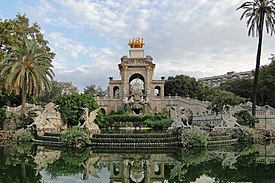Ciutadella park
| Parc de la Ciutadella | |
|---|---|

The park's fountain
|
|
| Type | Historical garden |
| Location | Barcelona |
| Coordinates | 41°23′17″N 2°11′15″E / 41.38806°N 2.18750°ECoordinates: 41°23′17″N 2°11′15″E / 41.38806°N 2.18750°E |
| Created | 1877 |
| Status | Open all year |
| Website | Parcs i jardins de Barcelona |
The Parc de la Ciutadella (Catalan pronunciation: [ˈparɡ də ɫə siwtəˈðeʎə], "Citadel Park") is a park on the northeastern edge of Ciutat Vella, Barcelona, Catalonia. For decades following its creation in the mid-19th century, this park was the city's only green space. The 70-acre (280,000 m2) grounds include the city zoo (once home to the albino gorilla Snowflake, who died in 2004), the Parliament of Catalonia, a small lake, museums, and a large fountain designed by Josep Fontserè (with possible contributions by the young Antoni Gaudí).
In 1714, during the War of the Spanish Succession, Barcelona was laid siege for 13 months by the army of Philip V of Spain. The city fell, and in order to maintain control over it, and to prevent the Catalans from rebelling as they had in the previous century, Philip V built the citadel of Barcelona, at that time the largest fortress in Europe.
A substantial part of the district it was constructed in (La Ribera) was destroyed to obtain the necessary space, leaving its inhabitants homeless. The fortress was characterized by having five corners, which gave the citadel defensive power, and by a rather wide surrounding margin, serving as location for the army's cannons. It included enough buildings to house 8,000 people.
Hundreds of Catalans were forced to work on the construction for three years, while the rest of the city provided financial backing for this and for warfare-related expenses as well, with a new tax named el cadestre. Three decades later a quarter was rebuilt around the fortress named Barceloneta, which is located inside the neighborhood Ciutat Vella.
...
Wikipedia
